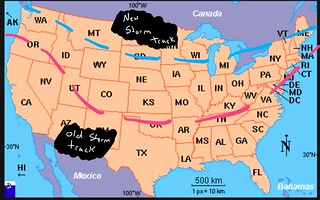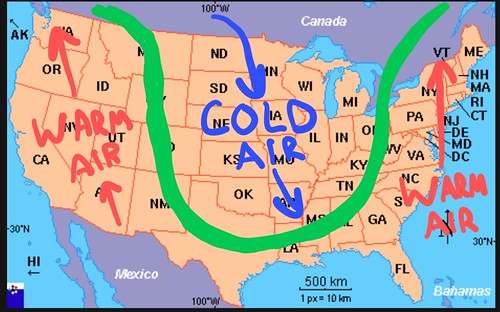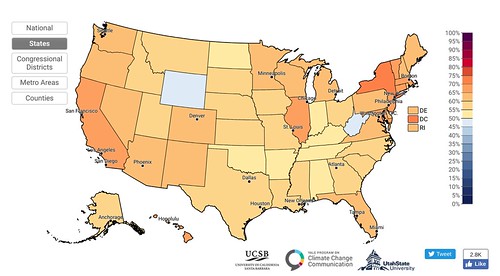Climate Change is, for certain, a hot-button topic in the United States. Because, for some people, they say there is a bit of a yo-yo effect (it was global cooling, then warming, now a change), for others it is a mistrust of the scientists data, while very few claim it to be some government conspiracy to control people’s minds – or something.
For this, my goal is to reach the first two groups. Even just a little bit. And the majority of others who already accept that Climate Change is happening, but still have questions.
And I’m going to start with something that may look confusing.

The knee-jerk reaction to this may be to say, “See, it isn’t actually warming up. Climate Change isn’t happening.”
And, part of that is true. It isn’t warming in Hattiesburg, Mississippi. But it is in, say, Duluth, Minnesota.

And it is in nearly every other part of the country. Except a few places in the southeast.
An Odd Trend
I’ve been looking at Climate Central data now since about 2012. Every time a new batch of data and graphics arrived, I take time to go in there and poke around to see where the data came from, how it was collected, and what the data say about other places.
Originally, I was in Amarillo, Texas when I started subscribing to the Climate Central data. So most of the time I would look at Amarillo and then the rest of Texas, Kansas and Oklahoma, and then into the Southeast.
But I started to notice that the trend lines in the data weren’t as steep in places like Louisiana and Alabama.
Then I moved to Mississippi. And requested data for Hattiesburg be added to their offerings. And the trend lines weren’t as steep, either. In fact, sometimes there was no trend at all. And other times, like the data above, the trend was actually cooling.
So, what gives?
Given the research I’ve read about, I have a hypothesis. And it is completely untested. More of an observational hypothesis than anything. An idea that may help explain why it is tough to experience a warming trend in the southeast. Perhaps someone can do some scholarly research on it.
Multiple different scientists, working independently as far as I can tell, have come to the conclusion that as our atmosphere warms, the Jet Stream will move north a bit more and may become a bit more wavy. And it may change how the atmosphere naturally works. There are some parts of the wavy data that still need to be ironed out, but in general, that is the idea.
That means that the general storm track will shift further north. But it also means that when kinks in the Jet Stream do occur, it will spill cold air even further south in some places. And, conversely, push warm air even further north in other places.
The end result is nullifying – when taking a longer-term average – any changes a warming climate would make for certain areas. And exacerbating that problem in others.
The Set-up and Payoff
Think of it this way: Storm systems, areas of low pressure, move along the Jet Stream. When storms systems move across the southeast they pull in large amounts of heat from the Gulf of Mexico. That is how there is severe weather in the southeast during the winter. As areas of low pressure move through, the southerly winds ahead of the system and cold front pull in air from as far south as the Caribbean.

When those systems are not there, and are instead much further north, there isn’t as much of a southerly flow. And therefore, the pull of heat from the Gulf and Caribbean isn’t there. And it is cooler.
At the same time, when the Jet Stream is more wavy, that means the peaks are higher and the dips are lower. So as the Jet Stream snakes its way around the globe it can dump much colder air further south.

And, in a warming atmosphere, the now-famed Polar Vortex can have a more difficult time staying in one piece. When pieces break off and sag south, behind a wavy Jet Stream, the – very – cold air can spill south with it.
The end result is sections of the country that – in particular, late winter and early spring – can actually be cooler, despite a warming atmosphere.
The hypothesis may explain why people in the southeast are also the least likely to say that a warmer atmosphere is changing the weather. Because, for them, it isn’t really.
So, What about Duluth
A great question! So why is Duluth still warming. And why is the non-trend only happening in the southeast?
For Duluth, because the Jet stream is shifting north, they end up on the south side of some of these storm systems, with a south, and warm, wind. When before, they were always on the north side.
Will they still get pummeled with cold air? Absolutely. But it used to be that they got plowed with cold, while rarely getting warmer at all.
That may be why some of the northern states are more likely to say that Global Warming is changing the weather. For them, it is.
As for why it is only in the southeast, the Rockies to the west, and the high plains are less effected due to geography and topography. The areas just aren’t set up the same way the southeast is. And, actually, the fact that the Rockies and the high plains are there, is what – in a way – leads to this weird phenomenon in the southeast. Because everything with weather is connected.
Not everything is binary
Humans like binary things. Yes or No. One or None. Go or stay. Our brains, in general, can’t handle information with fuzzy edges. And for some people in this country, Climate Change, Global Warming, or whatever you choose to call it, is fuzzy.
But that is what Climate Change is. Fuzzy. The end result is bad for the planet, but in some areas the direct effect on shorter and longer time scales may not be “Global Warming = warmer always”
And it is totally okay that hearing that may be difficult to digest. But it’s the truth based on all of the evidence found by nearly every scientist in the world. And it is important to remember that just because something isn’t happening to you, doesn’t mean it isn’t happening to someone else.
Just like you may drink three glasses of wine and not get tipsy, but others do. Same idea. Wine affects different people differently just like Climate change affects different people differently.
What do we do about it?
Well, a lot like too much wine, admitting there is a problem is the first step to correcting it. Now, I’m not a lawmaker. I’m a scientist. All I can do is present the data. The only goal was to present data that may explain the lack of direct, year-to-year, warming in the southeast like in other places. And how that may skew people’s perceptions.
But I will say, as a population, we elect lawmakers who can make changes to how to police certain industries or pollutants directly responsible for the things that are causing the climate to change. And once we all look at the data, we can then ask those lawmakers to make laws commensurate with how much we trust the data.
Because while, sure, the changing climate may not pose a direct impact on your weather, it might eventually change the weather in a place that grows your favorite food. Or produces your favorite products. Or changes a place you like to visit.



